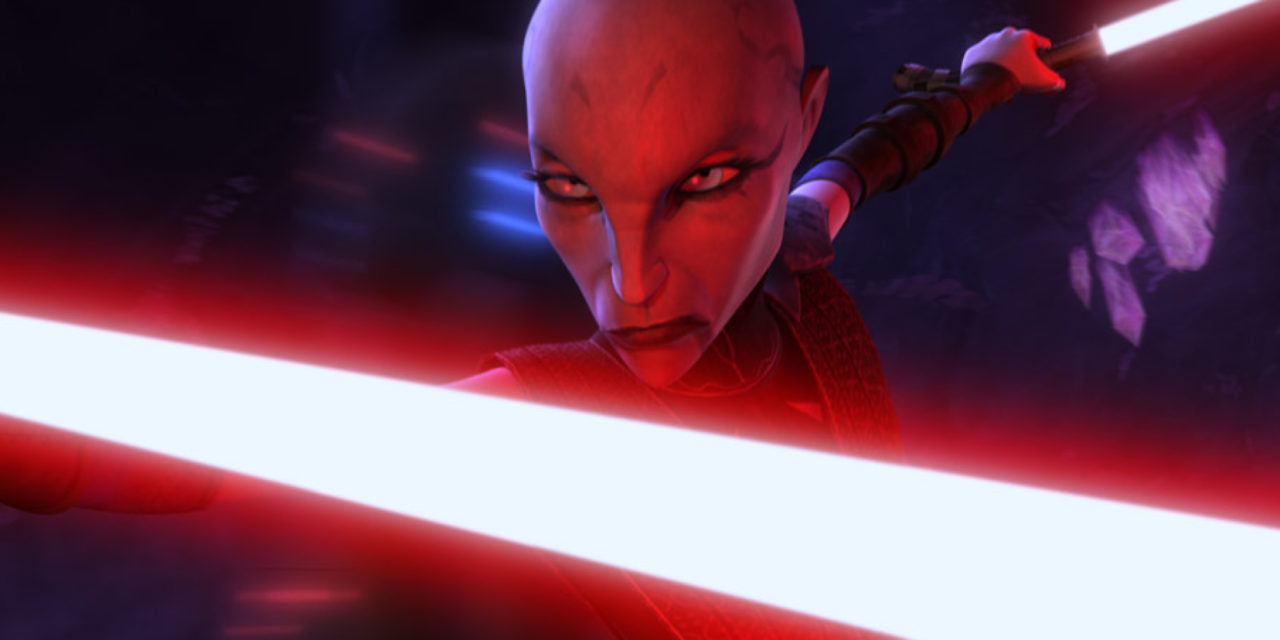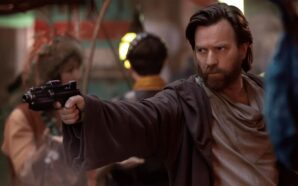For its first few seasons, Star Wars: The Clone Wars is haphazard and scattershot in almost every way. While rarely unenjoyable, the series is a jumble of tone, chronology, characters, and just overall quality. It’s midway through the third season when this changes and the show transcends from being good to great, which it maintains throughout the majority of its tumultuous seven-season run. I’ve always seen the episode Nightsisters, and the story arc it begins, as this turning point in the animated series. Despite everything that comes after, it’s still one of my favourite stories. But on a recent rewatch (which never ends because as soon as I finish the show, I go right back to the start again) it struck me that Nightsisters is not only a vital episode of the show, but a major milestone for Star Wars as a franchise.
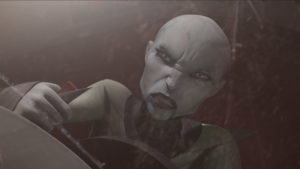 Nightsisters is Asajj Ventress’s episode. It begins and ends with her, the more well-known characters relegated to mere supporting roles in her narrative. It’s at this point the series and its creators are confident enough to look past the key cast of movie characters and instead develop a show-specific villain. Asajj may appear in the animated movie that kicked off the show, and multiple episodes in the earlier seasons, but this is truly the start of her arc. The episode she becomes an actual character rather than just an adversary for our heroes to face and flirt with when the writers decide they’ve used Dooku or Grievous too much recently, although the seasons building up her villainy ultimately prove necessary.
Nightsisters is Asajj Ventress’s episode. It begins and ends with her, the more well-known characters relegated to mere supporting roles in her narrative. It’s at this point the series and its creators are confident enough to look past the key cast of movie characters and instead develop a show-specific villain. Asajj may appear in the animated movie that kicked off the show, and multiple episodes in the earlier seasons, but this is truly the start of her arc. The episode she becomes an actual character rather than just an adversary for our heroes to face and flirt with when the writers decide they’ve used Dooku or Grievous too much recently, although the seasons building up her villainy ultimately prove necessary.
Asajj’s depth and character growth can be attributed to Katie Lucas, daughter of George but importantly a good writer in her own right, and she’ll go on to shepherd the character until the end of her journey. It’s a shame that we couldn’t see the Dark Disciple arc onscreen but the novel based on Katie Lucas’s unproduced scripts is a great read. Up to this point, Ventress has been Dooku’s assassin, an opponent to despise, but in Nightsisters we come to empathise with her, root for her even. Dooku turns on her and tries to kill her, proclaiming that she’s a failure. The truth is that it’s because she’s a success and Palpatine is beginning to fear her power so demands her death. The calm façade of Sidious is stripped away and we see him truly angry. He fears her, and Dooku succumbs to cowardice and does his master’s bidding.
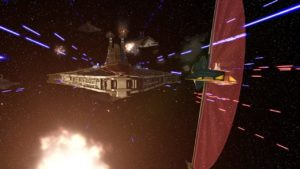 The larger thematic ideas and story beats are the truly important aspects of the episode but on a pure action level, every whizz, bang, and lightsaber clash is thrilling. With how much content the show can cram into a 22-minute episode, it’s easy to forget Nightsisters begins with a one of the best space battles of the show thus far. The episode kicks off an arc full of great, brutal lightsaber fights but since the final season aired, I can’t stop looking at the characters’ legs. The use of motion capture for the Maul/Ahsoka duel, with all the realistic steps, hops, and shifting of weight, makes the other duels look almost unprofessional in comparison, it’s that good. The characters just step forward, backwards, or leap without much thought on their lower halves by the animation team.
The larger thematic ideas and story beats are the truly important aspects of the episode but on a pure action level, every whizz, bang, and lightsaber clash is thrilling. With how much content the show can cram into a 22-minute episode, it’s easy to forget Nightsisters begins with a one of the best space battles of the show thus far. The episode kicks off an arc full of great, brutal lightsaber fights but since the final season aired, I can’t stop looking at the characters’ legs. The use of motion capture for the Maul/Ahsoka duel, with all the realistic steps, hops, and shifting of weight, makes the other duels look almost unprofessional in comparison, it’s that good. The characters just step forward, backwards, or leap without much thought on their lower halves by the animation team.
Asajj flees to her kin on Dathomir, this being the first appearance of the important planet in canon, which will later be seen in Rebels, Jedi: Fallen Order, and, who knows, maybe one day Solo 2. It’s on the mysterious red planet where the episode embraces being the ‘Temple of Doom’ of the Star Wars story. Like my favourite Indiana Jones film, which the series will go on to homage even more directly in season 6, Nightsisters introduces whole new levels of darkness and maturity. And that’s without mentioning the black magic. In terms of visuals, subject matter, and content, this arc pushes The Clone Wars to another level of darkness. To even reach Dathomir, Asajj has to brutally Force choke and kill four people simultaneously, and she’s the hero of the episode.
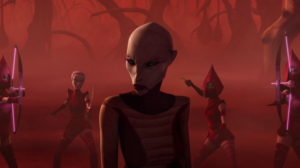 On Dathomir we meet the eponymous Nightsisters for the first time, a fascinating new tribe of Force users. The sisteren have a strange origin story: first seen in Ewoks: The Battle for Endor as classic, fantasy witches, they were later developed in the novel The Courtship of Princess Leia in 1994, and Nightsisters marked their first canon appearance. Part witch’s coven and part Bene Gesserit from Dune, the mysterious group is feared by Jedi and Sith alike, although both factions have flirted with forming ties with them in the past. They are led by Mother Talzin whose look was originally designed for The Phantom Menace when Palpatine’s apprentice was to be a ‘Sith Witch’ before Darth Maul was decided on. Composer Kevin Kiner never gets enough credit for his work on the series and his theme for the Nightsisters has a fun hint of Catwoman’s theme from Batman Returns to it.
On Dathomir we meet the eponymous Nightsisters for the first time, a fascinating new tribe of Force users. The sisteren have a strange origin story: first seen in Ewoks: The Battle for Endor as classic, fantasy witches, they were later developed in the novel The Courtship of Princess Leia in 1994, and Nightsisters marked their first canon appearance. Part witch’s coven and part Bene Gesserit from Dune, the mysterious group is feared by Jedi and Sith alike, although both factions have flirted with forming ties with them in the past. They are led by Mother Talzin whose look was originally designed for The Phantom Menace when Palpatine’s apprentice was to be a ‘Sith Witch’ before Darth Maul was decided on. Composer Kevin Kiner never gets enough credit for his work on the series and his theme for the Nightsisters has a fun hint of Catwoman’s theme from Batman Returns to it.
Nightsisters use the Force in a very different way from what we’re used to and it easily could have gone very wrong. Potions, spells, and bellowing green mist? Is that really Star Wars-y? Somehow the episode managed to pull it off and expands what we know of the Force, changing the canon forever. This bizarre “magick” opened the door to new interpretations of the Force and new powers that would go on to influence modern storytelling. Years before Luke in The Last Jedi called out the Jedi’s hubris and ownership of the Force, we saw that the Force didn’t belong to the Jedi right here. The council don’t understand the way the Nightsisters use the Force. It may be adjacent to the Dark Side but it is not Sith either. It’s a new faction using the Force in a new, refreshing way. Before Palpatine separated his soul from his body and sought a new vessel in The Rise of Skywalker, Mother Talzin did it in The Clone Wars.
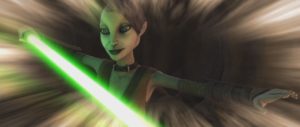 Ventress is weak when she reaches Dathomir and Talzin decides to gift her the Water of Life to help revive her. The ritual induces memories for Asajj that fuel her pain and anger, which we the audience are privy to with the use of flashbacks. Despite convoluted release orders, the actual story of each Star Wars film or episode is often incredibly linear. Nightsisters changes this idea and offers the very first on-screen flashbacks in live-action or animation. The Rashomon-style subjective flashbacks in The Last Jedi were the first on the big screen but television got there first. Using the same visual touches as Anakin’s visions in the prequels, we see Asajj’s tragic past play out before us and we finally begin to understand the character. Everyone she has known has been taken from her or cast her out, and she chooses to seek revenge on Dooku.
Ventress is weak when she reaches Dathomir and Talzin decides to gift her the Water of Life to help revive her. The ritual induces memories for Asajj that fuel her pain and anger, which we the audience are privy to with the use of flashbacks. Despite convoluted release orders, the actual story of each Star Wars film or episode is often incredibly linear. Nightsisters changes this idea and offers the very first on-screen flashbacks in live-action or animation. The Rashomon-style subjective flashbacks in The Last Jedi were the first on the big screen but television got there first. Using the same visual touches as Anakin’s visions in the prequels, we see Asajj’s tragic past play out before us and we finally begin to understand the character. Everyone she has known has been taken from her or cast her out, and she chooses to seek revenge on Dooku.
Turned invisible by magick and joined by two Nightsisters, Ventress launches an assassination attempt on Dooku in his home on Serenno. Despite being drugged and fighting opponents he can barely see, Tyranus successfully fends off his attackers and bests them. A benefit of a villain vs villain duel is that whoever the winner is is usually the person who loses in the show’s lightsaber fights. The Jedi, our flawed but noble heroes, often have to win so it’s great seeing Dooku actually be a force to be reckoned with instead of run away or lose his head/hands at the end. Ventress may have lost this round but she and Talzin decide to enact a new, more monstrous plan.
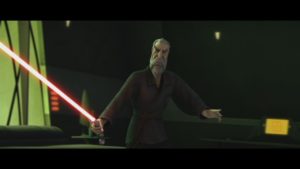 Nightsisters is the beginning of a new era of The Clone Wars, one defined by more mature storytelling and a willingness to take bold steps in a franchise often obsessed with repeating itself. Star Wars has developed so much in the decade since it has aired and its evolution can be traced back to some key defining moments; I believe Nightsisters is one of them. The production team had amassed confidence in their work and took risks. It offered a new tone and visual style that opened the doorway for future projects. The episode changed the way we saw the Force and how it is presented onscreen. It unleashed new storytelling techniques on the franchise with the use of flashbacks. Nightsisters even gave us a villain who became a morally-ambiguous protagonist/antihero in a franchise previously known for its simplistic black-and-white morality. And, most importantly of all, we got to see Dooku kick ass in his pyjamas.
Nightsisters is the beginning of a new era of The Clone Wars, one defined by more mature storytelling and a willingness to take bold steps in a franchise often obsessed with repeating itself. Star Wars has developed so much in the decade since it has aired and its evolution can be traced back to some key defining moments; I believe Nightsisters is one of them. The production team had amassed confidence in their work and took risks. It offered a new tone and visual style that opened the doorway for future projects. The episode changed the way we saw the Force and how it is presented onscreen. It unleashed new storytelling techniques on the franchise with the use of flashbacks. Nightsisters even gave us a villain who became a morally-ambiguous protagonist/antihero in a franchise previously known for its simplistic black-and-white morality. And, most importantly of all, we got to see Dooku kick ass in his pyjamas.
Do you think Nightsisters changed Star Wars forever? What would you say are the defining moments of the franchise? Let me know in the comments and be sure to geek out with me about TV, movies and video-games on Twitter @kylebrrtt.




